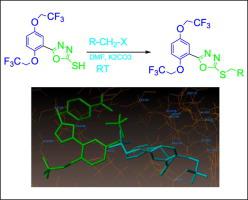Bioorganic Chemistry ( IF 4.5 ) Pub Date : 2021-05-31 , DOI: 10.1016/j.bioorg.2021.105046 Ramesh S Gani 1 , Avinash K Kudva 2 , Karabasanagouda Timanagouda 3 , Raghuveer 1 , Salma Begum Hussain Mujawar 4 , Shrinivas D Joshi 5 , Shamprasad Varija Raghu 6

|
Background
A hybrid molecule of different biologically active substances can improve affinity and efficiency compared to a standard drug. Hence based on this fact, we predict that a combination of fluorine, oxadiazole, sulfur, etc., may enhance α-glucosidase inhibition activity compared to a standard drug.
Methods
A series of novel 5-(2,5-bis(2,2,2-trifluoroethoxy)phenyl)-1,3,4-oxadiazole-2-thiol derivatives (2a-2i) were synthesized and characterized using spectroscopic techniques such as 1HNMR and LC-MS. In order to evaluate its bioactivity, in vitro α-amylase and α-glycosidase inhibitory activity were performed. In vivo study was carried using a genetic model, Drosophila melanogaster, for assessing the antihyperglycemic effects.
Results
The compounds 2a-2i demonstrated α-amylase inhibitory activity in the range of IC50 = 40.00–80.00 μg/ml as compare to standard acarbose (IC50 = 34.71 μg/ml). Compounds 2a-2i demonstrated α-glucosidase inhibitory activity in the range of IC50 = 46.01–81.65 μg/ml as compared to standard acarbose (IC50 = 34.72 μg/ml). Docking studies on a target protein, N-terminal subunit of human Maltase-glucoamylase (PDB:2QMJ) was carried and the compounds were found to dock into the active site of the enzyme (Fig. 1). The predicted binding energies of the compounds were calculated. The in vitro studies indicate that compounds 2b and 2g had better activity among the synthesized compounds. Whereas in vivo study indicates that 2b, 2g, and 2i could lower glucose levels in the Drosophila, but then 17–30% reduced capacity than acarbose and may be overcome by adjusting their dosage.
Conclusions
The in vitro and in vivo studies indicate that compounds 2b and 2g had better activity among the synthesized compounds. This study has recognized that compounds like 2b, 2g, and 2i may be considered potential candidates for further developing a novel class of antidiabetic agents.
中文翻译:

作为潜在的葡萄糖苷酶抑制剂的新型 5-(2,5-bis(2,2,2-trifluoroethoxy)phenyl)-1,3,4-oxadiazole-2-thiol 衍生物的合成
背景
与标准药物相比,不同生物活性物质的混合分子可以提高亲和力和效率。因此,基于这一事实,我们预测与标准药物相比,氟、恶二唑、硫等的组合可能会增强 α-葡萄糖苷酶抑制活性。
方法
合成了一系列新型 5-(2,5-bis(2,2,2-trifluoroethoxy)phenyl)-1,3,4-oxadiazole-2-thiol 衍生物(2a-2i ) 并使用光谱技术进行表征,例如1 HNMR和LC-MS。为了评价其生物活性,进行了体外α-淀粉酶和α-糖苷酶抑制活性。使用遗传模型黑腹果蝇进行体内研究,以评估抗高血糖作用。
结果
与标准阿卡波糖 (IC 50 = 34.71 μg/ml)相比,化合物2a-2i在 IC 50 = 40.00–80.00 μg/ml范围内表现出α-淀粉酶抑制活性。 与标准阿卡波糖 (IC 50 = 34.72 μg/ml)相比,化合物2a-2i在 IC 50 = 46.01–81.65 μg/ml范围内表现出α-葡萄糖苷酶抑制活性。对靶蛋白、人麦芽糖酶-葡糖淀粉酶 (PDB:2QMJ) 的N端亚基进行对接研究,发现化合物对接到酶的活性位点(图 1)。计算化合物的预测结合能。的体外研究表明,化合物2b的在合成的化合物中,2g具有较好的活性。而体内研究表明,2b、2g和2i可以降低果蝇中的葡萄糖水平,但其容量比阿卡波糖降低 17-30%,并且可以通过调整它们的剂量来克服。
结论
在体外和体内研究表明,化合物2b中和2克有合成的化合物中更好的活性。这项研究已经认识到,像2b、2g和2i这样的化合物可能被认为是进一步开发一类新型抗糖尿病药物的潜在候选物。


















































 京公网安备 11010802027423号
京公网安备 11010802027423号